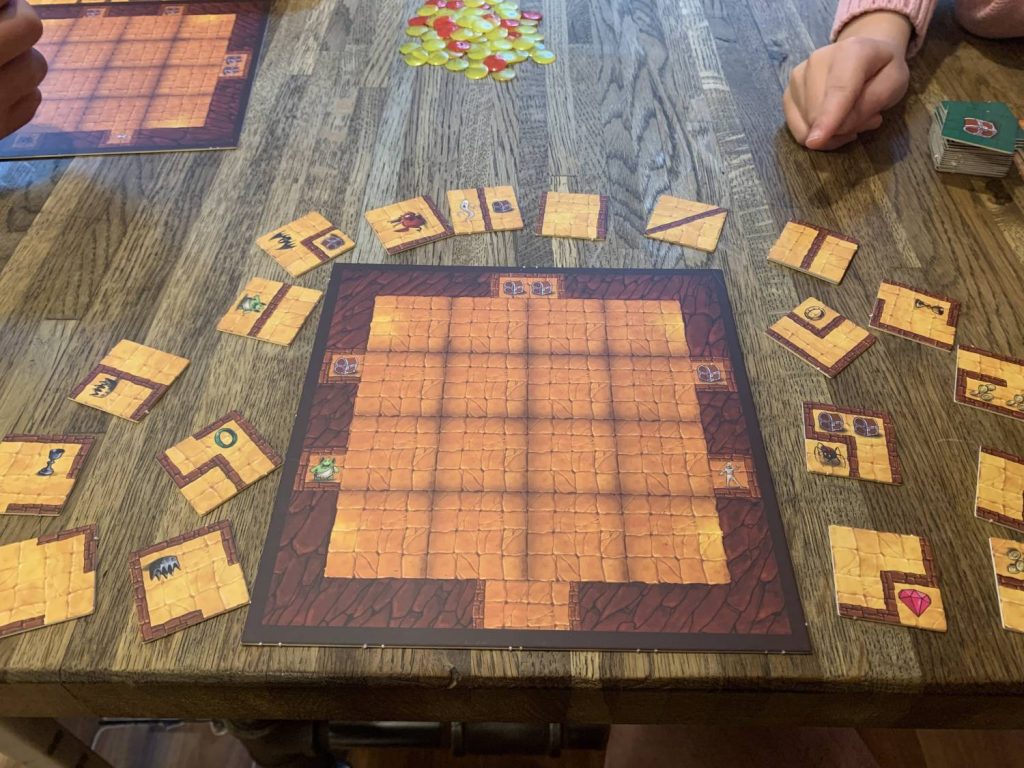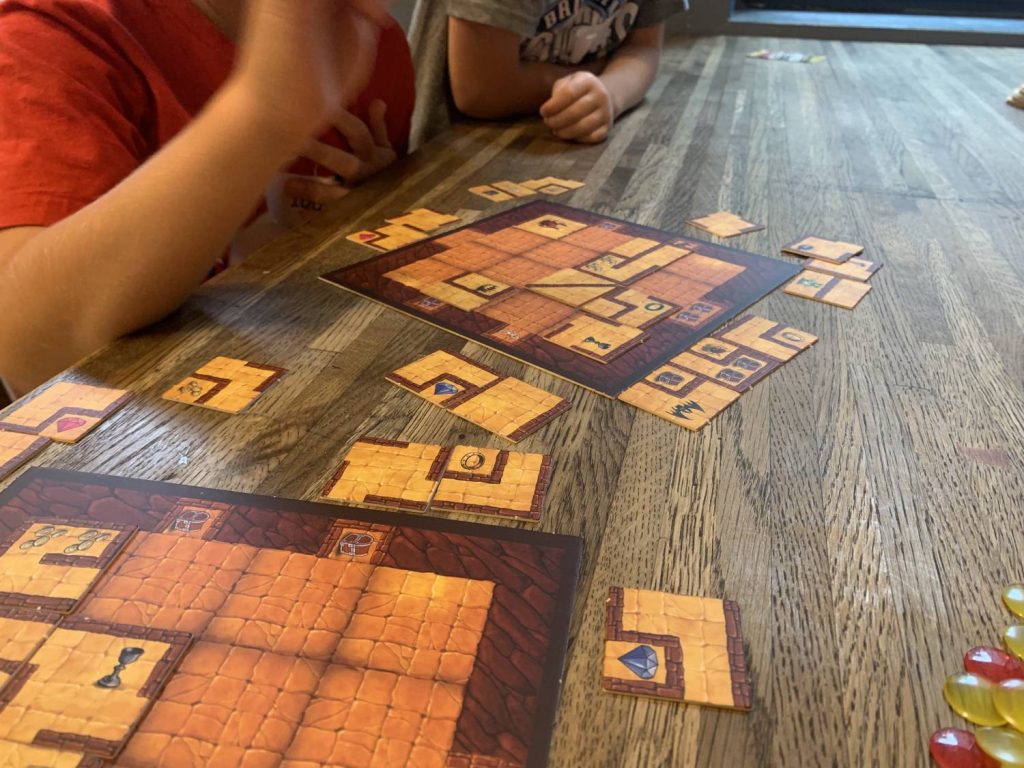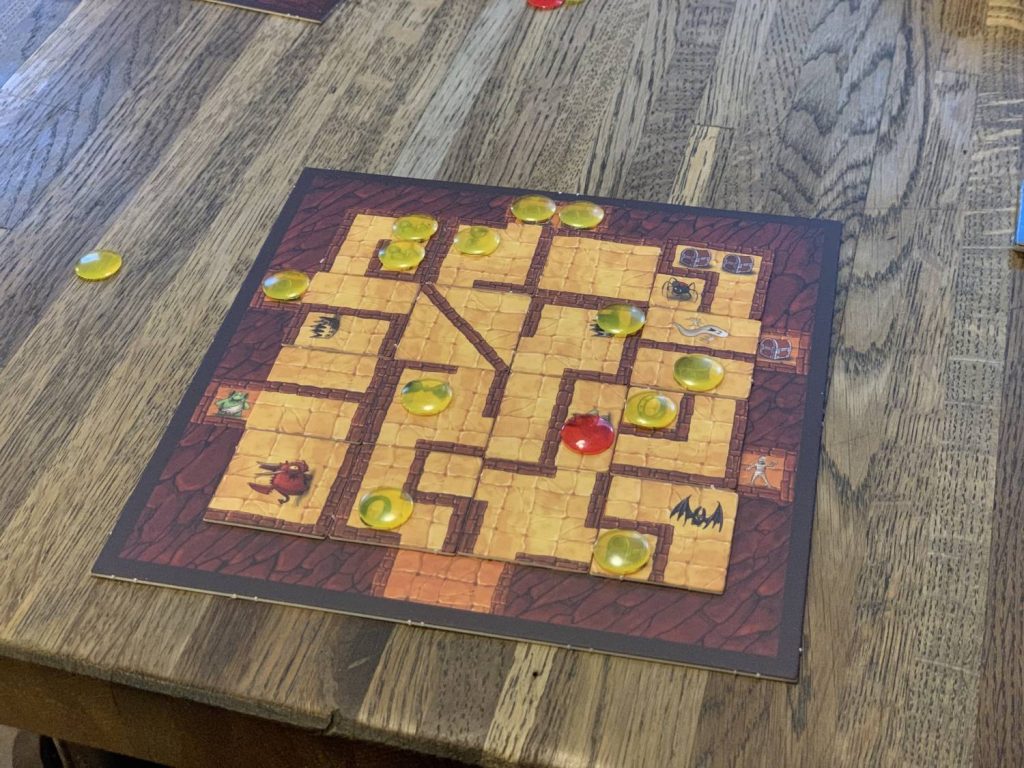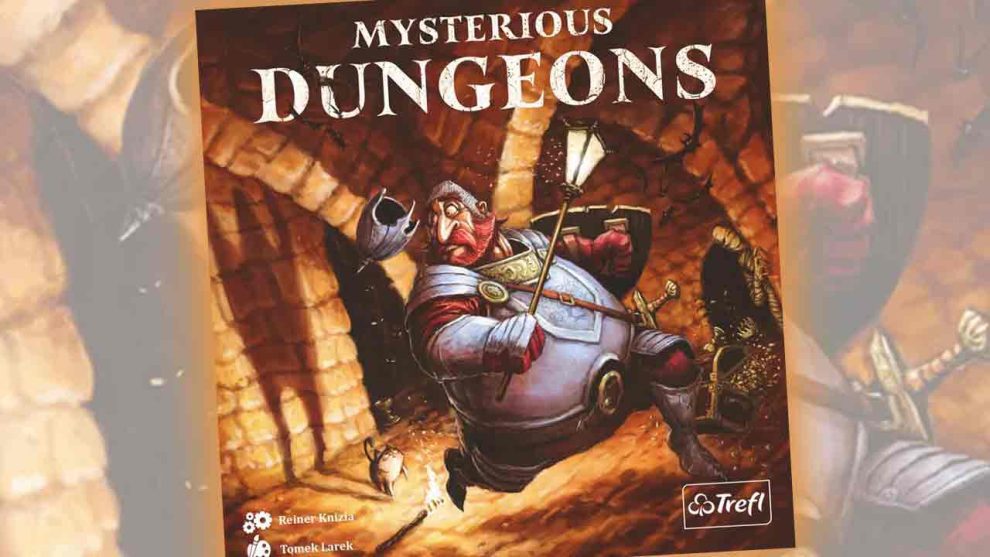Disclosure: Meeple Mountain received a free copy of this product in exchange for an honest, unbiased review. This review is not intended to be an endorsement.
When I read the rules for Mysterious Dungeons—which took all of thirty seconds—I was not excited to play. I wasn’t against the idea, but there wasn’t anything to get me jazzed. I’m by no means averse to a simple rule set, I prefer them in fact, but this seemed like well-trodden ground.
Here we have a family-weight tile placement game in which players try to create a path through their dungeon that will maximize their treasure haul while minimizing the number of monsters they encounter. Each player gets a player board and 20 titles. Most players set their tiles face-up on the table, but one player shuffles all of their tiles facedown, drawing one at the start of each turn. Everyone else picks up their matching tile and sets it somewhere, anywhere, in the 4 x 4 grid on their individual board.
You repeat this process until the dungeons are full. It’s quick, maybe 15 minutes. There are no adjacency rules, there’s no need to match walls, nothing so complicated. Once all the tiles have been placed, players enter their dungeons through the door, marking the accessible treasures and unavoidable monsters with gold and red tokens respectively. Each monster wipes out two treasures. Whoever has the most gold tokens is the winner.
I’ve played this game before, right? Like. This has been done. There isn’t anything to get excited about in that description. Having now played it, I was right not to be excited. Mysterious Dungeons would buckle under the weight of active investment, no question. Having said that, I also think I underestimated it?

4 Out of 5 Dentists
That there were no restrictions on placement concerned me. You can place them anywhere? Isn’t that awfully easy? It is, yes, but this is a family-weight game after all. It’s meant to be welcoming. Easy or not, you can be sure that I watched seven- and eight-year olds place their tiles with a lack of foresight that resulted in final scores of 1 or 2. I scored around 12 points on average, to give you an idea. 14 seems close to the upper limit, but I’m not doing the work to confirm that.
I also worried that the ability to place your tiles anywhere on the board would make the game effectively solvable. That is not the case. Four tiles are left over at the end of each game. That’s 20% of the supply. You’re playing with just enough certainty that smart placement will lead to better outcomes, but not enough certainty to know what those outcomes will be, exactly. You get the pleasure of placing a particular tile in a particular way in the hopes that your plans might work out, and then you get that jolt of smug satisfaction that comes from it working out perfectly.
Assuming it does, anyway, which it may not.
To put it in terms of how children experience that tension: more than once, I heard cackles of, “Hehehehe, that’s exactly the tile I wanted!,” and more than once, I heard a despondent, “Oh, no, this is a disaster.”

More Like Mysterious It’s-Been-Done-geons
This is the first English-language printing of Mysterious Dungeons, but publisher Trefl first released Reiner Knizia’s game in Polish back in 2016. It is a reskinning of 2015’s Cucina Curiosa, a German/French/Italian release that was identical in all manner save for the theme: instead of ransacking a dungeon, you’re chefs in a kitchen, trying to pick up the lobsters and avoid the fish bones.
I don’t understand why you would take a great theme and replace it with a generic one, but I’m not the professional here.
A Family Affair
In 100 Essays I Don’t Have Time to Write, playwright Sarah Ruhl talks about bringing her young daughter to her plays before they open. Children, she writes, are the best audience to test something on, because they are incapable of hiding when they get bored. She’s right. My most reliable group of review players are around nine years old. They’re not who I go to when I’m reviewing something like Bitoku, granted, but they’re game for just about anything. Observing nine-to-eleven year olds fall head over heels for Sarkaar day after day for a week certainly informed my review of it.
When I brought Mysterious Dungeons to the table, the kids visibly enjoyed it. Early tile placements were accompanied by self-satisfied shouts of “Oh, man, I’m in such a good position,” while later tile reveals elicited cries of agony. The moment we finished our first game, they asked if we could play again.
If you’re looking for a game to play with younger kids that won’t make your brain leak out your ears, Mysterious Dungeons is a good game, but if you’re looking for a game that you can play with children of disparate ages, Mysterious Dungeons is a great game. Everyone is playing on their own board and with their own pieces, so it would be easy to have a young-young play (or “play”) alongside older siblings.

On a Scale of One to Five
At the end of the second game, which was met by an equal amount of enthusiasm, I asked them what they thought.
“How would you rate this on a scale of 1 to 5?”
“Can we do 1 to 10?”
“Oh, sure.”
“I’d give it a 7.”
“I’d give it a 6.”
“Yeah, actually, I think that’s right, a 6.”
Kids don’t get enough credit for this. They’re not picky about what they do with their time, but they are discerning as to the quality of the activity. A 6 or 7 is just about how I’d rate Mysterious Dungeons myself.
In a world accustomed to Board Game Geek, where every game is between a 7.1 and a 7.4, that sounds bad. It’s certainly not great, but it is good. It’s pleasant. I’ve done more onerous things with my time. I don’t think designers should aspire to 6’s and 7’s, but sometimes that’s all you want to play. There are many, many games rated at between a 7.1 and a 7.4 that are much worse than Mysterious Dungeons.











Add Comment